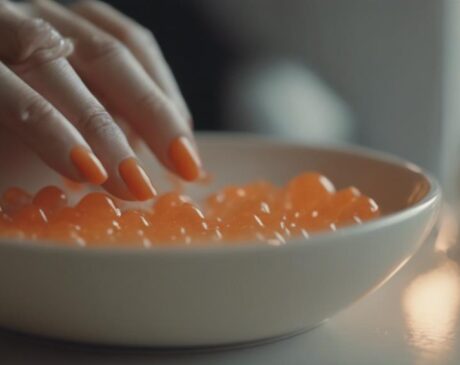How Do Nail Techs Remove Fake Nails?
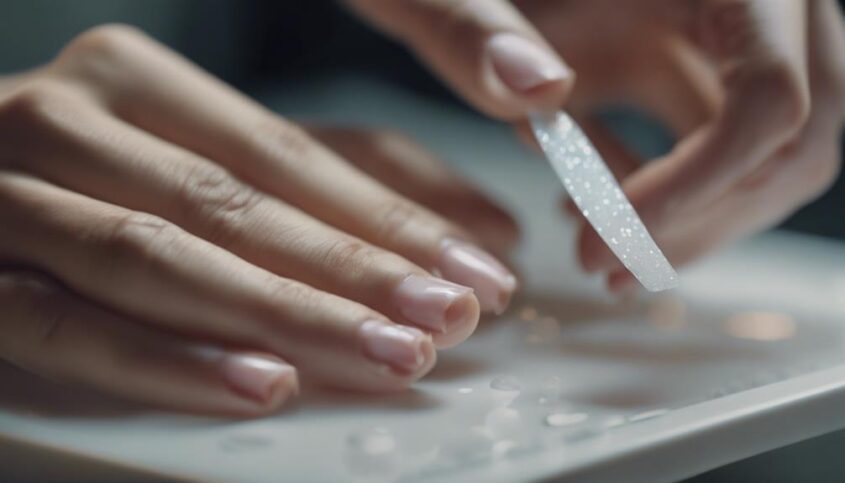
Nail technicians remove fake nails using techniques such as soaking in acetone, filing down extensions, using a nail drill, wrapping in foil, and carefully peeling off soft gel nails. These methods ensure safe and efficient removal while maintaining the health of your natural nails. Removing fake nails properly helps prevent damage and maintains the integrity of your nails.
Key Takeaways
- Soaking nails in acetone for removal.
- Filing down extensions smoothly.
- Using a nail drill with care.
- Wrapping nails in foil for efficiency.
- Peeling off soft gel nails gently.
Soaking in Acetone
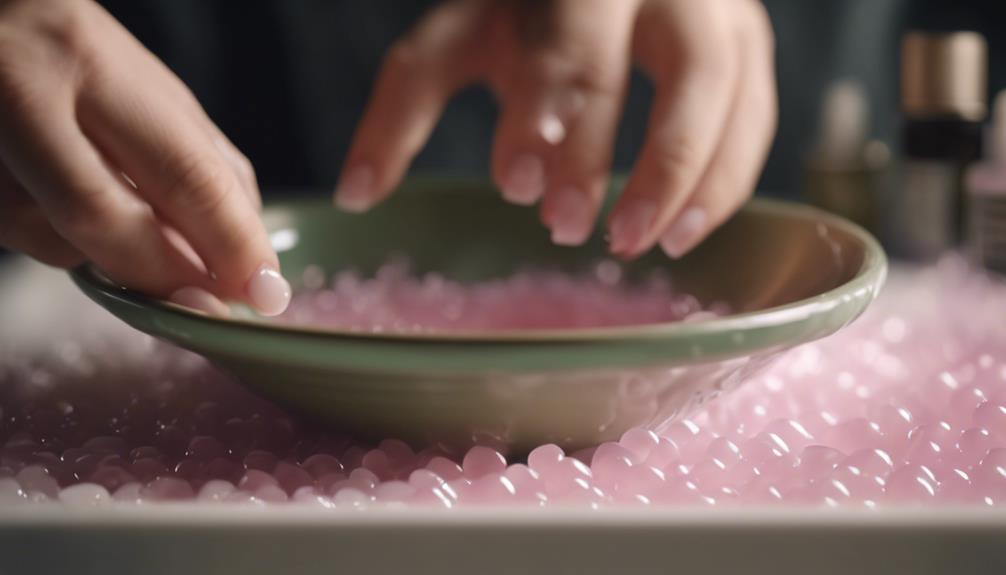
When removing fake nails, nail technicians often begin by soaking the nails in acetone to dissolve the adhesive bonds. However, with the rising concerns about the potential drying effects of acetone on nails and skin, many innovative alternatives have emerged. Acetone alternatives such as ethyl acetate or acetone-free nail polish removers are gaining popularity for their gentler approach to removing fake nails without compromising nail health.
Proper removal techniques are crucial to minimize damage to the natural nails. Nail technicians recommend wrapping each nail with a cotton ball soaked in the chosen solvent and then securing it with aluminum foil to effectively break down the adhesive. This method not only accelerates the removal process but also helps protect the surrounding skin from prolonged exposure to harsh chemicals.
After the fake nails have been successfully removed, nail health becomes a top priority. Providing aftercare tips such as moisturizing the nails and cuticles, applying a strengthening nail treatment, and allowing nails to breathe before applying new enhancements can help maintain the health and integrity of natural nails post-removal. These practices ensure that clients can enjoy beautiful nails without compromising their overall nail health.
Filing Down the Extensions
To prepare for the removal of fake nails, nail technicians commonly start the process by carefully filing down the extensions to reduce their thickness and facilitate the subsequent removal steps. This step is crucial in ensuring a smooth and efficient process while avoiding damage to the natural nails underneath. By filing down the extensions, technicians can gradually thin out the artificial material, making it easier to proceed with the professional removal techniques.
Professional removal of fake nails through filing requires skill and precision. Technicians use high-quality nail files to gently file away the bulk of the artificial extensions without causing harm to the underlying nail bed. This meticulous approach helps prevent any unnecessary stress or trauma to the natural nails, promoting overall nail health.
Using a Nail Drill
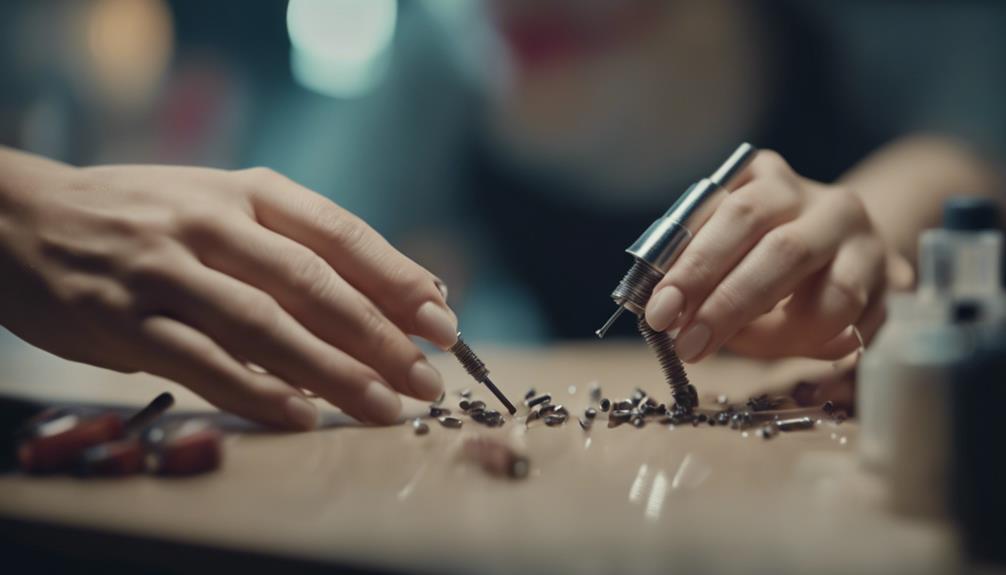
When utilizing a nail drill, nail techs must prioritize safety to prevent any potential harm to the client's natural nails.
Selecting the correct drill bit is crucial as it determines the effectiveness of the removal process and helps avoid damage.
Employing a gentle technique during the removal process is essential to maintain the health and integrity of the natural nails.
Nail Drill Safety
Ensuring proper training and understanding of nail drill safety protocols is essential for nail technicians when utilizing a nail drill during artificial nail removal procedures. Nail tech training should include certification requirements emphasizing safety precautions. To promote innovation and safety, technicians can explore nail drill alternatives that prioritize client well-being. Below is a table highlighting key safety measures for nail drill usage:
| Safety Precautions | Description | Importance |
|---|---|---|
| Proper Ventilation | Ensures removal of dust and fumes | Minimizes health risks |
| Speed Control | Adjust speed for different tasks | Prevents nail damage |
| Bit Sanitization | Disinfect bits after each use | Prevents infections |
Correct Bit Selection
For nail technicians, selecting the appropriate bit for a nail drill is paramount in ensuring efficient and precise artificial nail removal procedures. Proper technique and application are crucial in this process to avoid damage to the natural nail.
When choosing a bit, it is essential to consider factors such as the type of artificial nails being removed and the client's nail condition. Regular bit maintenance is also key to ensure optimal performance and safety during procedures. Technicians should inspect bits for any signs of wear and tear, replacing them when necessary.
Gentle Removal Technique
Selecting the appropriate technique for gentle removal using a nail drill is essential in minimizing any potential damage to the natural nail during artificial nail removal procedures.
When utilizing a nail drill for gentle removal, incorporating protective measures such as steam removal can help soften the artificial nails, making them easier to lift and remove without excessive force.
Additionally, after the fake nails have been successfully removed, providing an oil massage to the natural nails can help rejuvenate and nourish them, promoting healthy nail growth.
Post-removal care is crucial in ensuring the natural nails remain strong and undamaged. By following these steps and techniques, nail techs can effectively and gently remove fake nails while prioritizing the health and integrity of the client's natural nails.
Wrapping in Foil
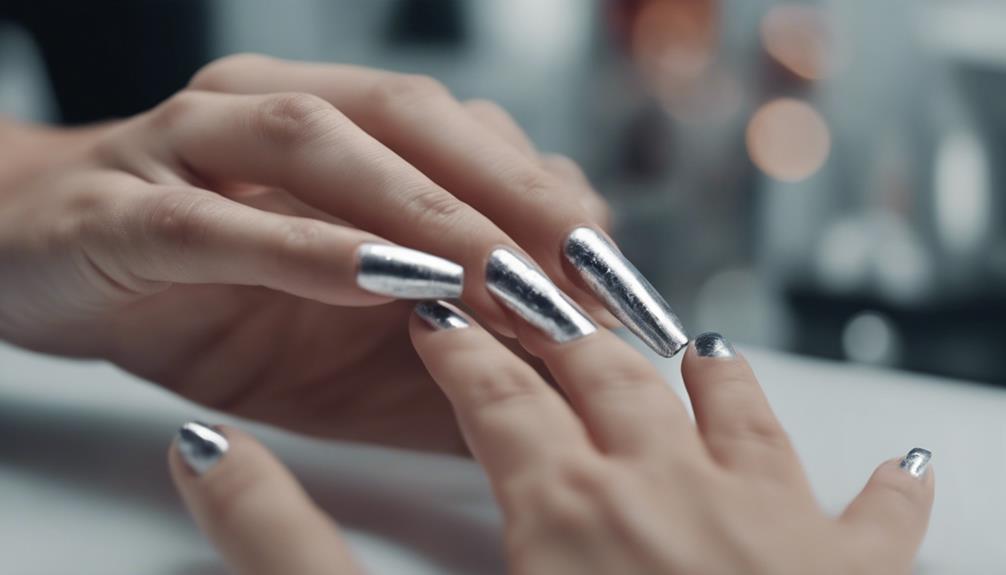
Let's explore the efficient method of wrapping fake nails in foil to facilitate their removal.
This technique involves soaking the nails in acetone to loosen the adhesive, making it easier to take off the artificial nails.
The process typically takes around 15-30 minutes, depending on the type of fake nails and the strength of the adhesive used.
Foil Wrap Method
The foil wrap method is a commonly used technique by nail technicians to effectively remove fake nails. This innovative approach offers a gentle and efficient way to take off artificial nails without causing damage to the natural nails.
Here are three key benefits of the foil wrap method:
- Minimizes exposure to harsh chemicals
- Helps retain moisture in the nails
- Facilitates a quicker removal process
Acetone Soak Process
Utilizing the acetone soak process in conjunction with wrapping nails in foil is a common technique employed by nail technicians for effectively removing artificial nails. While acetone is the most common solvent used due to its efficiency in breaking down the adhesive, some individuals opt for acetone alternatives to reduce potential damage and preserve the natural nails.
Wrapping the nails in foil helps to contain the acetone and create a more controlled environment, enhancing the removal process. It is crucial to follow proper techniques when attempting DIY removal to minimize the risk of damaging the nails.
Nail technicians often recommend professional removal to ensure the safety and health of the natural nails.
Removal Time Frame
For optimal results when using the foil wrapping method to remove fake nails, it is essential to adhere to a specific removal time frame. The duration of the process is crucial to overcome removal challenges efficiently while considering time constraints. To maintain nail health and ensure a successful transition, implementing a well-thought-out aftercare routine is imperative.
- Precision Timing: Ensuring the foil wraps stay in place for the designated period.
- Efficient Removal: Minimizing the time spent on each nail to streamline the process.
- Post-Removal Care: Implementing a thorough aftercare routine to promote nail health and recovery.
Peeling Off Soft Gel Nails
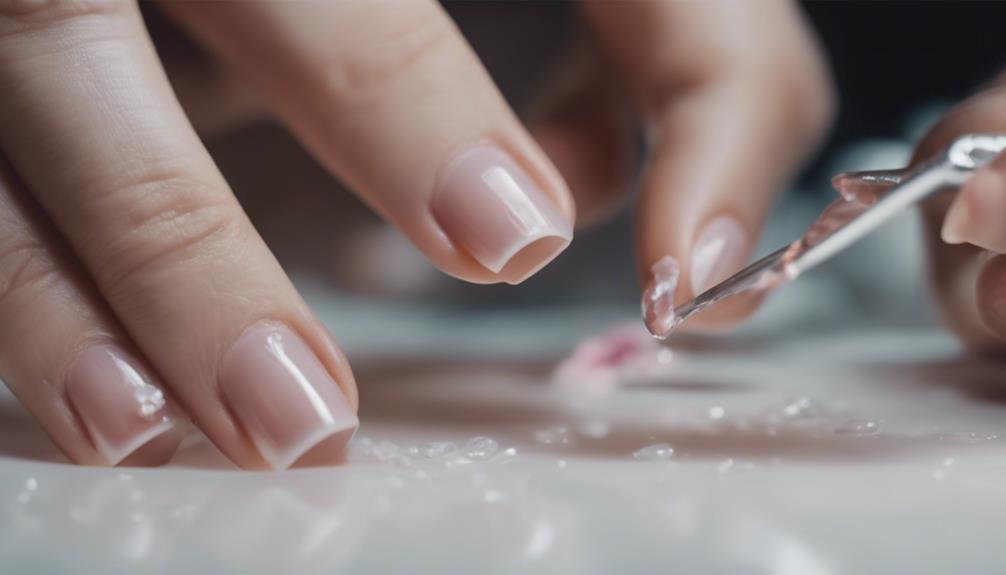
With proper technique and care, soft gel nails can be safely peeled off without causing damage to the natural nails. Gel nail care and maintenance are essential for healthy nails.
To peel off soft gel nails at home, start by gently buffing the shiny top coat to break the seal. Next, soak a small piece of cotton in acetone, place it on the nail, and wrap the fingertip in foil to hold it in place. After about 10-15 minutes, the gel should start to lift off. Gently push the gel off using a cuticle pusher, being careful not to force it or damage the natural nail underneath.
Once the gel is removed, moisturize the nails and cuticles to restore hydration. Soft gel nails offer a versatile canvas for various nail art and design ideas. Experiment with different colors, textures, and embellishments to create unique and stylish looks that showcase your creativity.
Lifting With Cuticle Pusher
To safely remove soft gel nails, gently lift the gel using a cuticle pusher, ensuring careful precision to avoid damaging the natural nail. Cuticle care plays a vital role in maintaining nail health, and utilizing a cuticle pusher correctly can contribute to overall nail wellness.
Here are three innovative ways to lift soft gel nails with a cuticle pusher:
- Gentle Pressure: Apply gentle pressure when lifting the gel to prevent trauma to the nail bed.
- Angle Technique: Use the cuticle pusher at a slight angle to ensure a smooth and controlled lift.
- Patience and Precision: Take your time to lift the gel slowly and precisely, focusing on preserving the natural nail underneath.
Moisturizing and Nourishing Nails
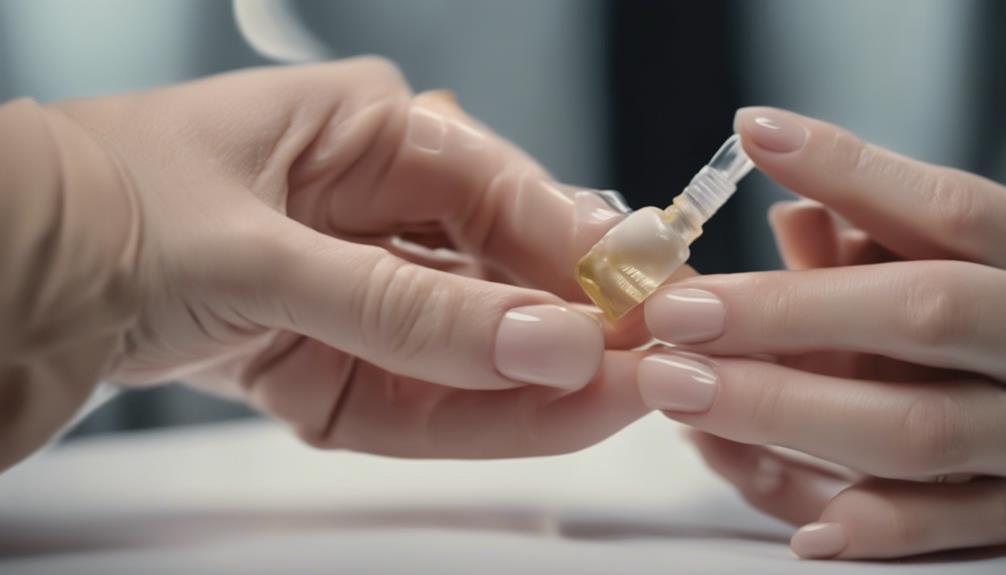
Moisturizing and nourishing nails is essential for maintaining their health and strength. Nail care goes beyond aesthetics; it plays a crucial role in the overall well-being of your nails. Hydrating treatments are an innovative way to keep your nails looking and feeling their best.
Hydrating treatments help replenish moisture in the nails, preventing them from becoming dry and brittle. These treatments often contain ingredients like vitamin E, jojoba oil, and shea butter, which are known for their nourishing properties. By incorporating hydrating treatments into your nail care routine, you can promote nail health and resilience.
Regularly moisturizing your nails can also help prevent issues such as peeling, cracking, and breakage. It is recommended to apply a hydrating treatment or nail oil at least a few times a week to keep your nails in optimal condition. Remember, healthy nails are an essential part of overall nail care, and nourishing them is a simple yet effective way to maintain their strength and beauty.
Frequently Asked Questions
Can Fake Nails Be Removed Without Acetone?
Natural nail alternatives offer quick removal techniques for fake nails without acetone. Methods such as soaking in warm water, using dental floss, or gently prying with a cuticle pusher can effectively remove fake nails without harsh chemicals.
Are There Any Alternative Methods to Removing Fake Nails at Home?
Exploring DIY alternatives for safe removal techniques of fake nails at home can be intriguing. From gentle soaking in warm water to using dental floss for separation, innovative methods can provide convenience and care.
How Long Does It Typically Take for Fake Nails to Soak off in Acetone?
The soaking time for fake nails in acetone typically ranges from 15 to 30 minutes. Alternatives to acetone soaking include using a nail file or seeking professional removal. Proper removal process and precautions should be followed to protect nail health.
Can Fake Nails Damage Your Natural Nails During Removal?
Nail health is akin to a delicate dance; protecting the natural nail during fake nail removal is paramount. By employing meticulous techniques and quality products, nail techs can prevent damage, ensuring the integrity of the natural nail remains intact.
What Should Be Done if a Nail Tech Accidentally Cuts or Damages the Natural Nail During the Removal Process?
In the event of accidental nail damage during removal, nail techs should prioritize nail repair and proper treatment. Utilizing innovative techniques and products, they can restore the natural nail's health and appearance effectively, ensuring client satisfaction and safety.
Conclusion
In conclusion, nail techs have various methods for removing fake nails. These methods include soaking in acetone, filing down the extensions, using a nail drill, wrapping in foil, peeling off soft gel nails, lifting with a cuticle pusher, and moisturizing and nourishing the nails.
How can these techniques ensure a smooth and flawless transition back to natural nails?


